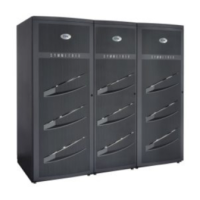70
EMC Symmetrix DMX-3 Product Guide
Symmetrix DMX-3 Hardware
Symmetrix systems use the following logical volume structure:
◆ Each logical volume has n cylinders
◆ Each cylinder has 15 tracks (heads)
◆ Each track has 128 blocks of 512 bytes
Therefore, a Symmetrix logical volume with n cylinders has a usable
block capacity of:
n * 15 * 128
n for each volume is defined during Symmetrix configuration.
To calculate the size of the logical volume:
Number of cylinders * heads * blocks * 512
(n * 15 * 128* 512)
Note: “Open systems hypervolumes” on page 127 provides information on
configuring open systems logical volumes.
Flexible device
geometry
(for Sun Solaris hosts)
Flexible device geometry improves interoperability when migrating
data between DMX-3 or DMX-4 and older Symmetrix systems. When
the Symmetrix DMX-3 was introduced, the disk geometry presented
to the host by the disk array changed. The number of sectors per track
was doubled to 128, which also led to a doubling of the cylinder size.
In the Sun Solaris operating system, disk geometry, disk size,
manufacturer ID, and the partition table are stored in the label in
sector 0 of the disk. The label is written to the disk using the format
utility, which makes a device usable to the OS. When a Solaris device
is opened for I/O activity, the label is written to host cache and the
SCSI driver uses the partition information to translate relative
partition addresses to device absolute logical block addresses.
The difference between disk geometries will not cause issues in most
scenarios. However, there are three pieces of information contained in
the disk label that, if modified, can cause a new label to be written by
the operating system. If disk geometry, manufacturer ID, or the size
of the disk drive change, format will write a new label if “auto
configure” is run from the format> type menu, followed by label.
When a device is migrated to a DMX-4 or DMX-3 using a product
that produces a track-by-track copy of the source device on the target
device (SRDF, RecoverPoint, or Open Replicator for example), the
entire device is migrated including the VTOC label. When this occurs
between devices with heterogeneous disk geometries, there will be a
difference between the disk geometry written in the label on the
target (which was copied from the source) and the disk geometry that

